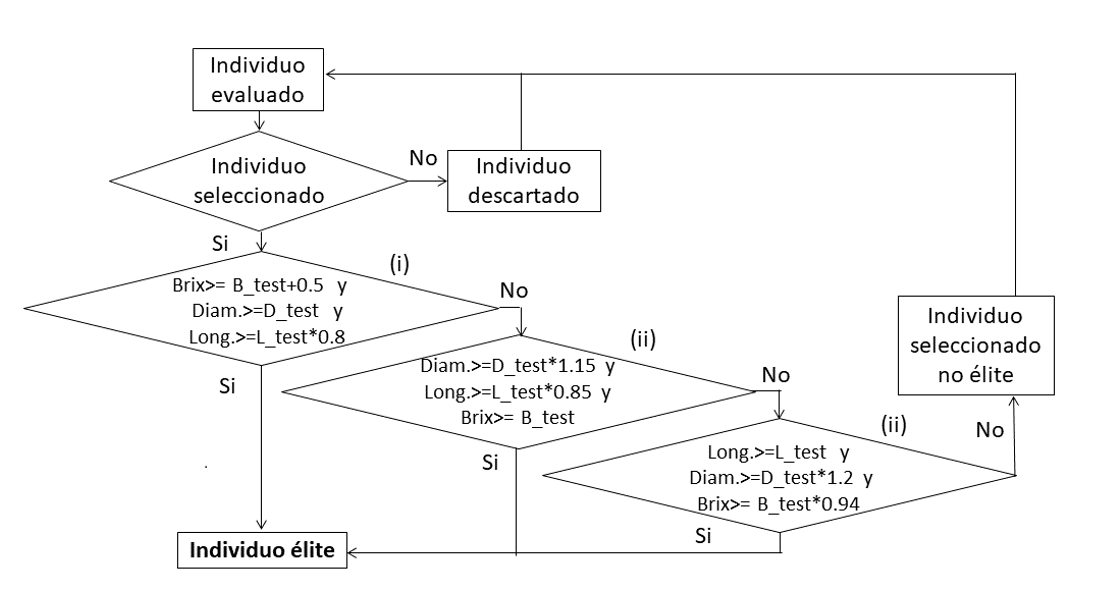Elite genotypes for the evaluation of crosses in sugarcane genetic breeding
Main Article Content
Abstract
Efficient sugarcane breeding programs require availability of diverse germplasm and they are facilitated by formulation of appropriate selection strategies and procedures. The objective of the present study is the detection and use of genotypes or elite individuals as a criterion for the evaluation of crosses of the Sugarcane Breeding Program in the southeastern region of Cuba. The data from the selection evaluations of the stages of the genetic breeding scheme belonging to clonal propagation 1, 2 and replicated studies (period 2000-2014) were used. A classification algorithm was established to detect elite individuals on the variables diameter, stem length and refractometric brix compared to the control cultivar. The repeatability of the individuals and crosses where the elite individuals were classified from one stage to the other was determined. It was possible to detect the crosses that provide elite individuals, with significantly higher values in the clonal selection stage 2 to replicated studies than in the first clonal selection stage. The repeatability of the elite individuals in the clonal selection stages increases in the final stages of selection with respect to the initial one. The effectiveness of classification of these elite individuals in becoming recommended cultivars was 28.3 % when detected in clonal stage 1 compared to 85.3 % in clonal stage 2.
Article Details

This work is licensed under a Creative Commons Attribution-NonCommercial 4.0 International License.
Those authors who have publications with this journal accept the following terms of the License Attribution-NonCommercial 4.0 International (CC BY-NC 4.0):
You are free to:
- Share — copy and redistribute the material in any medium or format
- Adapt — remix, transform, and build upon the material
The licensor cannot revoke these freedoms as long as you follow the license terms.
Under the following terms:
- Attribution — You must give appropriate credit, provide a link to the license, and indicate if changes were made. You may do so in any reasonable manner, but not in any way that suggests the licensor endorses you or your use.
- NonCommercial — You may not use the material for commercial purposes.
- No additional restrictions — You may not apply legal terms or technological measures that legally restrict others from doing anything the license permits.
The journal is not responsible for the opinions and concepts expressed in the works, they are the sole responsibility of the authors. The Editor, with the assistance of the Editorial Committee, reserves the right to suggest or request advisable or necessary modifications. They are accepted to publish original scientific papers, research results of interest that have not been published or sent to another journal for the same purpose.
The mention of trademarks of equipment, instruments or specific materials is for identification purposes, and there is no promotional commitment in relation to them, neither by the authors nor by the publisher.
References
Yadav S., Jackson P., Wei X., Ross E., Aitken K., Deomano E., Atkin F., Hayes B., Voss-Fels, K. Accelerating Genetic Gain in Sugarcane Breeding Using Genomic Selection. Agronomy. 2020;(10):585; doi:10.3390/agronomy10040585.
Yang K., Jackson P., Wei X., Wu C., Qing W., Zhao J., Yao L., Zhao L., Zhao, Y.; Zhao P., Chen X., Liu J., Li F. Optimizing selection indices in sugarcane seedlings. Crop Science. 2021; (61):3972–3985; doi: 10.1002/csc2.20602.
Hoarau J., Dumont T., Wei X., Jackson P., D’Hont A. Applications of Quantitative Genetics and Statistical Analyses in Sugarcane Breeding. Sugar Tech. 2021; (24): 320–340. doi.org/10.1007/s12355-021-01012-3.
Zhou M., Gwata E. Location Effects and Their Implications in Breeding for Sugarcane Yield and Quality in the Midlands Region in South Africa. Crop Science. 2015; 55(6):1–11; doi:10.2135/cropsci2015.02.0101
Mbuma N.; Zhou M.; Van der Merwe R. Estimating breeding values of genotypes for sugarcane yield using data from unselected progeny populations. Euphytica. 2020;(2): 216; doi.org/10.1007/s10681-019-2540-0.
Mbuma N., Zhou M., Van der Merwe, R. Identifying Elite Families and Determining Optimum Family Selection Rates in Sugarcane Breeding. Crop Sci. 2017; (57):2525–2537; doi: 10.2135/cropsci2017.01.001.
Jorge H, González R, Casas M, Jorge I. Normas y Procedimientos del Programa de Mejoramiento Genético de la Caña de Azúcar en Cuba. INICA: PUBLINICA La Habana; 2011. Available from: https://www.revista.icidca.azcuba.cu/wp-content/uploads/2023/03/Vol.-57-No.1.-enero-abril-2023.pdf
Rodríguez R, Puchades Y, Abiche W, Rill S, García H. SASEL: software for data management generated in the Cuban sugarcane-breeding program. Proceedings of the International Society of Sugar Cane Technologists. 2016; 29:63-6. Available from: https://www.google.com/url?sa=t&source=web&rct=j&opi=89978449&url=https://ediciones.inca.edu.cu/index.php/ediciones/article/download/1685/3332/8947&ved=2ahUKEwiE2-G-25CJAxVpSzABHVNRHXoQFnoECBkQAQ&usg=AOvVaw2EvA0MgnIB9dDoISV-q6tU
Rodriguez R., Puchades, Y., Abiche W. Metodología de validación y manejo de cruces en la mejora genética en caña de azúcar. Cultivos Tropicales. 2020; 41(1); e02. Available from: https://www.google.com/url?sa=t&source=web&rct=j&opi=89978449&url=https://ediciones.inca.edu.cu/index.php/ediciones/article/view/1536&ved=2ahUKEwjW7PDl25CJAxVuTDABHVNfBUYQFnoECBMQAQ&usg=AOvVaw19IZw8mgMXrI4bUSMcYCvK
Stringer J., Cox M., Atkin F., Wei X., Hogarth D. Family selection improves the efficiency and effectiveness of selecting original seedlings and parents. Sugar Tech. 2011; (13):36–41. doi:10.1007/s12355-011-0073-5.
Peternelli L., Bernardes D., Brasileiro B., Barbosa M., Silva R. Decision Trees as a Tool to Select Sugarcane Families. American Journal of Plant Sciences. 2018; (9):216-30. doi:10.4236/ajps.2018.92018.
Kimbeng C., Cox M. Early generation selection of sugarcane families and clones in Australia: a review. Journal of the American Society of Sugar Cane Technologists. 2003 (23):20–39. Available from: https://www.google.com/url?sa=t&source=web&rct=j&opi=89978449&url=https://www.researchgate.net/publication/313172965_Early_generation_selection_of_sugarcane_families_and_clones_in_Australia_A_review&ved=2ahUKEwiLguj925CJAxWIQjABHdx1AMAQFnoECBYQAQ&usg=AOvVaw1VidpACNKtyYnsiLveN3Iu
Cursi D., Cox M., Anoni C., Hoffmann H., Gazaffi R., Franco A. Comparison of different selection methods in the seedling stage of sugarcane breeding. Agronomy Journal. 2020; 112; (6):4879-4897; doi.org/10.1002/agj2.20431.
Mbuma N.; Zhou M.; Van der Merwe R. Evaluating parents for cane yield in sugarcane breeding using best linear unbiased prediction analysis of progeny data derived from family plots. South African Journal of Plant and Soil. 2018;1-8; doi.org.10.1080/02571862.2018.1465136.
Jackson P. What is the optimal selection intensity of seedlings (stage 1) in sugarcane breeding programs? International Sugar Journal. 2018; 1435: 542–546. Available from: https://www.google.com/url?sa=t&source=web&rct=j&opi=89978449&url=https://www.semanticscholar.org/paper/What-is-the-optimal-selection-intensity-of-(stage-Jackson/f8840dc5017e77e04f69453c1bac073f15611818&ved=2ahUKEwjk2tqR3JCJAxW5RTABHU4dIfUQFnoECBYQAQ&usg=AOvVaw2RwwVjU1HvMg20reZWlSCR
